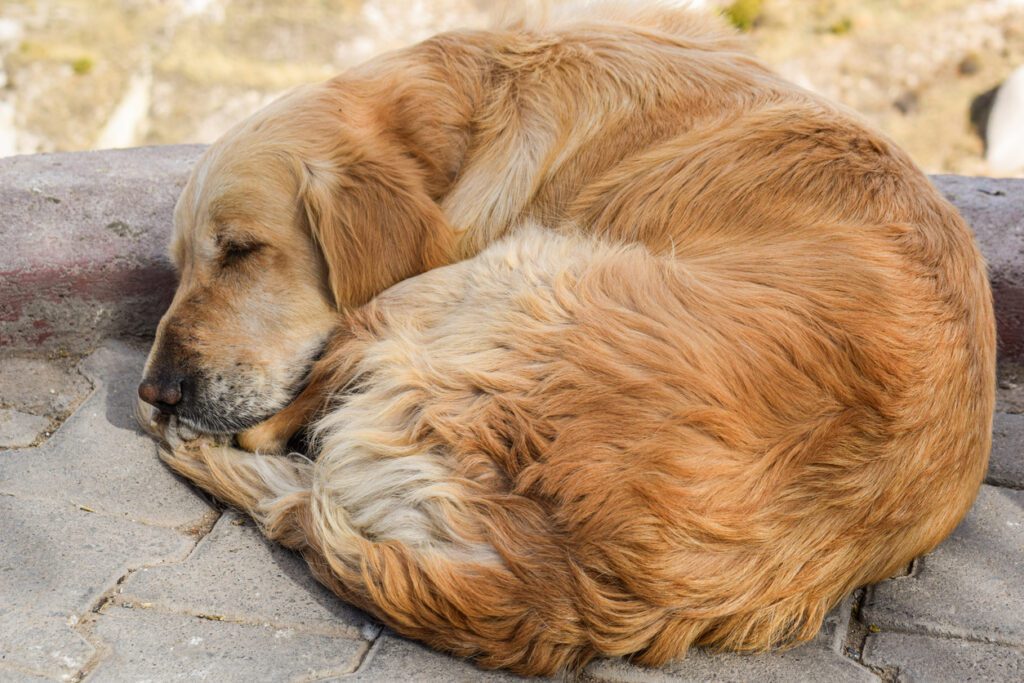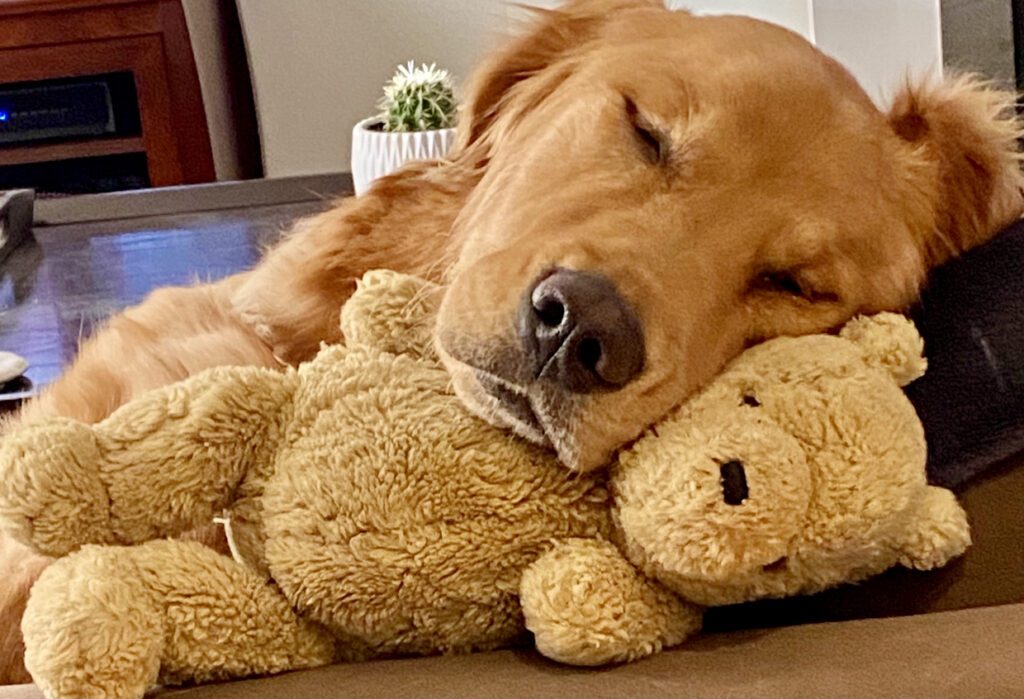I’ve always been fascinated by how technology helps us better understand our health. Monitoring my sleep with my Apple Watch has been eye-opening—I’ve learned how much my sleep patterns affect my overall well-being. But that got me thinking… what about our dogs? If our sleep health is so important, could tracking our furry companions’ sleep also make a difference in their health? Sleep monitoring isn’t just for humans anymore, and exploring our pets’ sleep habits might open new doors to understanding their wellness.
Have you ever caught your dog twitching, growling, or even softly barking in their sleep? My dogs, Teddy and Bear, do it all the time. It’s both endearing and fascinating to watch. Sometimes, I wonder what they’re dreaming about. Are they chasing tennis balls or reliving a belly rub session? Believe it or not, research suggests that dogs’ brain wave patterns during sleep are strikingly similar to ours. This means that, just like us, they’re dreamers. Dream on, doggos!
But beyond the adorable quirks, a dog’s sleep patterns can teach us valuable insights about their health and well-being. Let’s explore what makes canine rest unique, why it matters, and how you can help your furry friend get the best sleep.

The Unique Sleep Patterns of Dogs
Just like humans, dogs go through various stages of sleep. They typically alternate between periods of light sleep (when they might be partially aware of their surroundings) and deep sleep, which includes REM (Rapid Eye Movement) sleep. During REM sleep, dreaming happens, and you’ll likely see those funny twitches, growls, or paw movements.
However, unlike humans, dogs are adaptable sleepers. They don’t consolidate their sleep into one long stretch at night like we do. Instead, they take shorter naps throughout the day, accumulating an average of 12-14 hours of sleep daily.
Factors That Influence a Dog’s Sleep Patterns
- Age
Puppies and senior dogs sleep much more than healthy adult dogs. Puppies can snooze for 18-20 hours daily as their growing bodies and developing brains demand more rest. Elderly dogs, on the other hand, may need extra sleep because of reduced energy levels and age-related health issues.
- Breed
Larger breeds, like Great Danes and Saint Bernards, tend to require more extended sleep than smaller, more energetic breeds like terriers or beagles.
- Activity Levels
Dogs with highly active lifestyles, such as working dogs or those on daily runs with their owners, often require more sleep to recover. Couch-potato pooches may nap simply out of boredom or habit.
- Environment
Noise levels, household routines, and even the comfort of a dog’s bed can significantly impact how deeply (or poorly) it sleeps.
Why Your Dog’s Sleep Matters
Adequate sleep is crucial for your dog’s physical and mental health. During sleep, their bodies repair tissues, their immune systems recharge, and their memory and learning abilities improve. Puppies, in particular, need rest to absorb all the training and new experiences they’re exposed to.
On the flip side, sleep deprivation can lead to behavioral problems in dogs, such as irritability, anxiety, and a decreased ability to focus during training. Long-term sleep disturbances could also weaken their immune system, leaving them more prone to illnesses.
Red Flags in Your Dog’s Sleeping Habits
It’s normal for dogs to adjust their sleep patterns slightly as they age or your routine changes. However, significant, sudden changes in your dog’s sleep habits could indicate an underlying health issue. Here are some red flags to watch for:
- Excessive Daytime Sleepiness: If your dog seems lethargic or uninterested in their usual activities, it’s worth consulting a vet.
- Frequent Restlessness at Night: In older dogs, this could be a symptom of pain, anxiety, or cognitive dysfunction.
- Snoring or Labored Breathing During Sleep: While occasional snoring can be regular (especially in certain breeds like pugs or bulldogs), consistent snoring or gasping sounds may indicate respiratory problems.
- Unusually Short Sleep Periods: If your dog isn’t sleeping enough and appears stressed or hyperactive, it could be a sign of discomfort or an underlying issue like joint pain.
If you spot any of these signs, don’t shrug them off. Your vet can help determine whether your dog’s sleep troubles are linked to diet, health conditions, or environmental stressors.

How to Help Your Dog Sleep Better
Creating a comfortable sleep environment for your dog can improve their sleep quality. Here are some practical tips:
- Invest in a Quality Dog Bed
Look for a bed that suits your dog’s size and sleeping style. Orthopedic beds are great for older dogs, while burrow-style beds may help anxious dogs feel safe.
- Set a Routine
Dogs thrive on predictable schedules. Establish regular feeding, play, and sleep times to help them feel secure and relaxed.
- Provide calming sounds
Note: I sleep more soundly when playing White or Brown noise through the night, so I assume that Teddy and Bear also benefit from these calming sounds.
- Physical and Mental Stimulation.
Make sure your dog gets plenty of exercise and engagement during the day. A tired dog is a happy, well-rested dog!
- Minimize Noise and Distractions
Create a quiet sleeping area away from loud house-like sounds. White noise, soft music, or calming sounds can help settle anxious dogs (as mentioned earlier).
- Monitor Their Diet
Ensure your dog eats high-quality food and doesn’t snack too close to bedtime, which may disrupt its rest.
- Keep Their Sleep Space Cool
Dogs, primarily breeds with thick coats, sleep better in cooler spaces (me too). If your pup enjoys burrowing, feel free to add a light blanket.
Dream On, Doggos
At the end of the day (literally), your dog’s sleep is as essential to its health as good quality food and regular exercise. By paying attention to your dog’s unique sleeping habits and creating an environment that promotes rest, you’re helping your dog’s body function better and ensuring sweet dreams of tennis balls, chasing squirrels, and endless belly rubs.
Have you noticed any funny or quirky habits while your dog sleeps? Maybe they sleep upside down, stretched out, or cuddled in the tiniest ball they can manage. Drop your stories in the comments below—I’d love to read about all the unique ways your pup dreams!
And remember, staying informed is key to being the best dog owner you can be. If your dog needs professional guidance with their sleeping habits, don’t hesitate to consult your vet. Sweet dreams, dog lovers! 🐾
References:
Why Is My Dog Up All Night?. https://woofysh.com/why-is-my-dog-up-all-night/
7 Fun and Easy Ways to Customize Your Dog’s Sleeping Area – PrideBites. https://pridebites.com/blogs/barking-post-blog/7-fun-and-easy-ways-to-customize-your-dog-s-sleeping-area
Thank you for reading this blog post. If you have any questions or comments, please leave them in the Comments section below.
Copyright © 2019. I Don’t Know All The Answers, Nikki Mastro.
All of my photographs and documents are copyrighted.
The three photos included in this blog post are from the iStock.com library.
No part of this website, including text, photographs, and documents, may be reproduced, stored in a retrieval system, or transmitted in any form or by any means without written permission from the copyright holder. All unauthorized use is strictly prohibited. If you choose to copy or share any information from my site, you must provide a link to the source. I appreciate your cooperation.
For further information concerning “I Don’t Know All The Answers,”
– Website and Blog: https://www.idontknowalltheanswers.com
– Facebook: https://www.facebook.com/Nikki.L.Mastro/
– Instagram: https://www.instagram.com/i_dont_know_all_the_answers/
– Linkedin: https://www.linkedin.com/in/nikki-mastro-05455a3a/
– YouTube Channel: https://www.youtube.com/@idontknowalltheanswers1954

